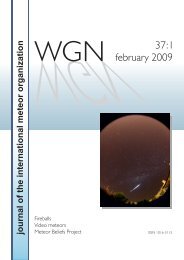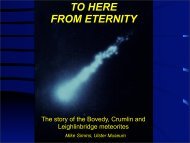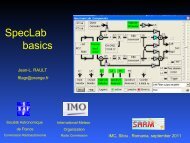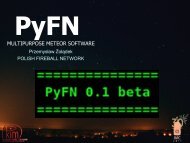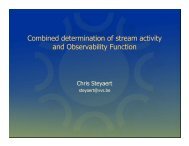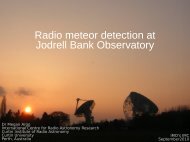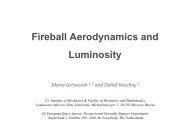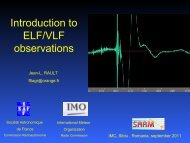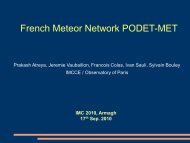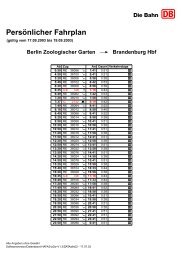Chris Steyaert: Meteor Trajectory from Multiple Station Head Echo ...
Chris Steyaert: Meteor Trajectory from Multiple Station Head Echo ...
Chris Steyaert: Meteor Trajectory from Multiple Station Head Echo ...
You also want an ePaper? Increase the reach of your titles
YUMPU automatically turns print PDFs into web optimized ePapers that Google loves.
<strong>Meteor</strong> <strong>Trajectory</strong> <strong>from</strong> <strong>Multiple</strong> <strong>Station</strong> <strong>Head</strong> <strong>Echo</strong><br />
Doppler Observations<br />
<strong>Chris</strong> <strong>Steyaert</strong><br />
steyaert@vvs.be
Principle<br />
• Reflection on the path (mirror)<br />
• Reflection on the head<br />
Armagh september 2010 VVS <strong>Chris</strong> <strong>Steyaert</strong><br />
2
Typical spectrogram<br />
Armagh september 2010 VVS <strong>Chris</strong> <strong>Steyaert</strong><br />
3
Simulated Doppler for observed fireball<br />
Armagh september 2010 VVS <strong>Chris</strong> <strong>Steyaert</strong><br />
4
Detailed head echo<br />
Analysing the .wav file<br />
Armagh september 2010 VVS <strong>Chris</strong> <strong>Steyaert</strong><br />
5
Earlier research<br />
• Manning et al., 1949.<br />
"Radio Doppler Investigation of <strong>Meteor</strong>ic Heights and<br />
Velocities".<br />
Journal of Applied Physics, Vol. 20, p.475-479.<br />
• Richardson, J. and Kuneth W. (1998).<br />
"Revisiting the Radio Doppler effect for forwardscatter<br />
meteor head echoes".<br />
WGN, Journal of the IMO. “26, 117-130”.<br />
Armagh september 2010 VVS <strong>Chris</strong> <strong>Steyaert</strong><br />
6
Some maths<br />
6 observations →<br />
position M (3 parameters) and velocity vector v (another 3) can<br />
be determined<br />
Armagh september 2010 VVS <strong>Chris</strong> <strong>Steyaert</strong><br />
7
VVS beacon /<br />
receiving network<br />
Armagh september 2010 VVS <strong>Chris</strong> <strong>Steyaert</strong><br />
8
Worked out real case<br />
12 Dec 2009, 20h38 UT Geminid<br />
sure about identification?<br />
Armagh september 2010 VVS <strong>Chris</strong> <strong>Steyaert</strong><br />
9
standard Geminids radiant<br />
α = 113 º, δ = +32 º<br />
at the location of the beacon:<br />
Az = 257 º, h = 34 º<br />
Armagh september 2010 VVS <strong>Chris</strong> <strong>Steyaert</strong><br />
10
Numerical procedure<br />
• ‘Simplified ‘ procedure for streams:<br />
– velocity vector is known (v = 34400 m/s)<br />
– starting value for M = (0, 0, 90000)<br />
• Miminize the Doppler and Doppler rate errors<br />
M = (-16000, -18000, 96000) at t = 0<br />
• For the mid point of the head echoes:<br />
• Why Coussens no HE?<br />
Armagh september 2010 VVS <strong>Chris</strong> <strong>Steyaert</strong><br />
11
Sensitivity analysis<br />
• Error source<br />
– timing accuracy (NTP synchronised)<br />
– outlier removal?<br />
• Monte Carlo simulation<br />
– Std dev 5 ms<br />
Armagh september 2010 VVS <strong>Chris</strong> <strong>Steyaert</strong><br />
12
Simulation results<br />
Armagh september 2010 VVS <strong>Chris</strong> <strong>Steyaert</strong><br />
13
Conclusions / the future<br />
• Accuracy<br />
– Several km, strongly depending on geometry of the receivers<br />
around the transmitter<br />
– Sensitive (few %) to speed<br />
• Need better time reference<br />
• Full procedure for non-stream meteors<br />
• Number: average 10 / day ? Statistics of head echoes<br />
• Automate the analysis<br />
Armagh september 2010 VVS <strong>Chris</strong> <strong>Steyaert</strong><br />
14
Thanks to<br />
• The beacon observers<br />
• BIPT (Belgian Inst. Post and Telecom)<br />
• Felix Verbelen<br />
• Gaspard De Wilde<br />
• David Entwistle<br />
• Astrolab IRIS, Zillebeke<br />
• VVS<br />
• Pierre Terrier<br />
Armagh september 2010 VVS <strong>Chris</strong> <strong>Steyaert</strong><br />
15



